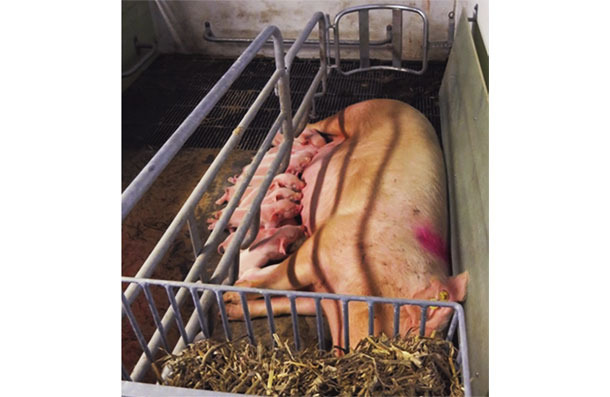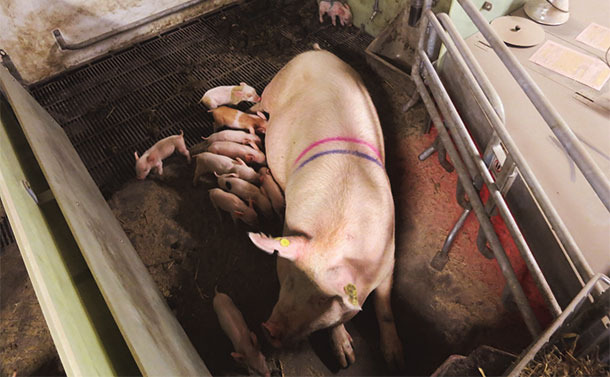The housing system in the farrowing phase needs to reconcile the needs of sows and piglets. In Europe, most sows are confined in crates from one week before to three weeks after the farrowing. From an economic standpoint, this housing system has advantages such as saving space and management time, the ability to maintain high levels of hygiene in the pen and a lower risk of crushing piglets. However, other studies have shown that farrowing crates have a negative impact on the sow's physiology and behaviour at farrowing, generating a stress response that may eventually affect the length of farrowing and piglet viability. For this reason, several European countries are investing resources into research of alternative housing systems. Results so far have not been consistent, some systems and studies showing little difference as regards neonatal mortality between conventional crates and alternative systems, and others suggesting a higher mortality in the latter. Neonatal mortality does not only depend on the design of the farrowing crate, but also on genetic and management factors, as well as litter size, especially with the increased use of hyper-prolific dam lines. This paper briefly reviews these different factors, in addition to some new housing systems for lactating sows.
Management measures related to stress-reduction in lactating sows may contribute to a better farrowing and lactation dynamics. In this regard, the control of environmental temperature, interventions and noise, an adequate supply of water and food, and the provision of nesting materials are essential. Similarly, measures that contribute to increase the piglets' vitality are especially important, specifically in case of low birth weight piglets from hyper-prolific dams. Important factors to emphasize to improve piglet vitality include: Ensuring proper colostrum intake, standardization of litters considering the piglet weight in relation to the average weight of the litter, and maintaining the proper temperature to prevent hypothermia. Genetics studies have been published in Denmark and the Netherlands suggesting that selection for certain characters may simultaneously reduce neonatal mortality and increase litter size, although it is complex. Direct selection for neonatal survival has been so far the most successful strategy. Selection for birth weight homogeneity of the litter has great potential, although it requires highly complex statistical approaches. Selection for parenting skills and robustness is possible, but it requires a clear identification of the criteria for selecting these characters.


Photo 1 SWAP (Sow Welfare and Piglet Protection) system in the temporary confinement of the sow period.
Courtesy of Christian Fink Hansen

Photo 2 SWAP system in the sow-stall-free period. Courtesy of Christian Fink Hansen
In the area of farrowing crates design, efforts have been made to improve the comfort they provide as regards space for the sow and safety for the piglets. However, much of the research in recent years has been focused on crateless farrowing systems. There are housing models such as the UMB-farrowing pen, the PigSAFE pen or the Werribee Farrowing pen, based on the principle of removing the farrowing crate and creating two areas, one for the sow and another one for the piglets’ safety. This second area is obtained by placing fences, protective panels in areas most likely to collapse —such as the pen walls—, or protective nests that are attractive for the piglets. Although the results reported on these systems are not all consistent, the problem of neonatal mortality is not fully resolved, especially in warm climates where protective nests are less used by piglets in hot conditions. For this reason work is also underway on semi-confinement systems, like the one presented recently in studies in Denmark. Given that mortality tends to concentrate in the first 3-4 days after farrowing, systems such as SWAP are being tested, in which the sow is kept in its crate during this period and then allowed free movement. The results on neonatal mortality have so far been promising and, when comparing restriction periods for the sow, 4 days have been suggested to be sufficient (see Table 1 for a summary of reproductive data with the SWAP system.) Notably, these confinement systems require the adoption of adapted management guidelines (monitoring, adoptions...) and data on economic costs on commercial terms are not yet available. These semi-confinement systems have also been combined with the practice of allowing contact between different litters of piglets, which is rare in the current farrowing crates. Under natural conditions, however, this contact starts at about 10 days of life, when the sow returns to the group. Some results suggest that this practice may reduce the stress associated with the establishment of hierarchies in times such as weaning or after the split marketing, thus reducing aggression and, therefore, promoting growth.
Table 1. Reproductive data per sow comparing the semi-confinement system SWAP
(with two confinement strategies) to stall-free sows during farrowing. Source: Hales et al., 2015
| SWAP | |||
| CONFINED DURING FARROWING | NOT CONFINED DURING FARROWING | STALL-FREE SOWS | |
| Born, No. | |||
| Total born | 17.7 | 18.1 | 17.7 |
| Live born | 17.0 | 17.1 | 16.6 |
| Standardised litter size | 13.8 | 13.7 | 13.7 |
| Neonatal mortality , %1 | |||
| before standardisation | 3.7 | 7.0 | 7.5 |
| from standardisation to day 4 | 5.6 | 6.7 | 7.6 |
| from day 4 to weaning | 6.6 | 6.9 | 5.6 |
1 Calculated as the percentage of live births before standardisation and the percentage of standardised litter after standardisation



